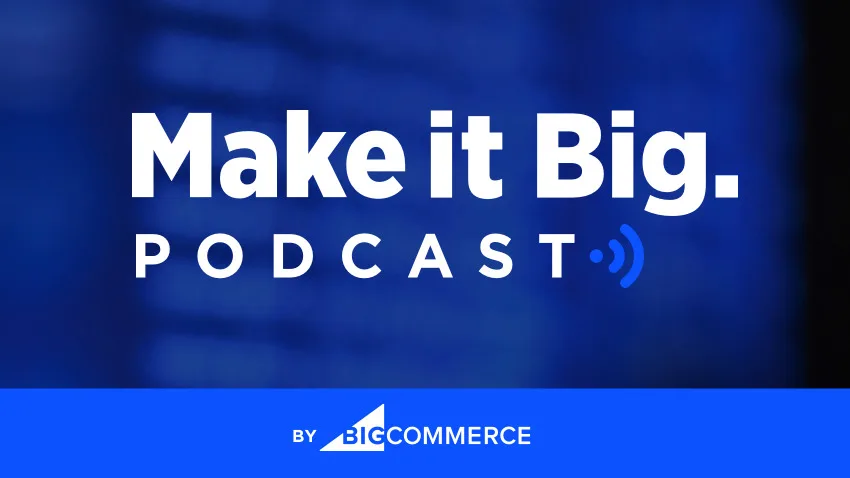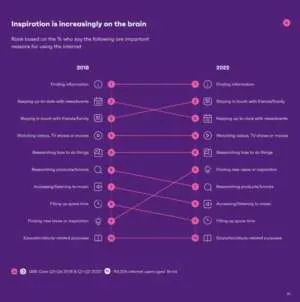
Ecommerce insights on the go
Tune in to the Make it Big Podcast — our thought leadership audio series for retailers, entrepreneurs and ecommerce professionals. You'll get expert insights, strategies and tactics to help grow your business.

Partnerships for Ecommerce Businesses: A Powerhouse for Increased Revenue, Brand Awareness and Engagement


Partnerships for Ecommerce Businesses: A Powerhouse for Increased Revenue, Brand Awareness and Engagement
Get The Print Version
Tired of scrolling? Download a PDF version for easier offline reading and sharing with coworkers.
A link to download the PDF will arrive in your inbox shortly.
Roughly 96% of people don’t trust ads. Changes in consumer behavior mean businesses need to adapt their marketing strategies to reach consumers where they hang out. Partnerships provide companies with the unique opportunity to build consumer relationships and trust without being pushy.
Cristy Garcia, CMO at impact.com, explains the advantages of partnerships:
“From a business point of view, working with referral partners helps to capture demand, enhance customer experience, enable innovation, yield high ROI, allow brands to acquire new customers and crucially, to create competitive advantage.”
Learn how partnerships can tap into all the above benefits for your ecommerce business.
Internet Search Trends and Behavior
People go online for three main reasons: entertainment, information and connection. Most users skip past ads. They prefer to find things independently instead of being bombarded with overly promotional ads.
Internet search trends for 2018 versus 2022:

Source: GWI
The trend of finding information held steady in the top place from 2018 to 2022. Finding inspiration jumped from ninth to sixth place since 2018, overtaking product research. Google searches show an increasing number of people typing in terms like “inspo” and “ideas.”
The above data shows consumers are increasingly looking to have more fun and get inspired on the internet. Brands should find new and creative ways of drawing in customers and keeping them engaged.
Digital Advertising Has its Challenges
The everyday consumer doesn’t trust digital ads anymore — which is why ad effectiveness diminishes. Changes to BigTech, like Apple’s privacy updates and Google’s phasing out third-party cookies, make it harder to target consumers. Additionally, Facebook and Google ads oversaturate the online space.
However, digital advertising remains an integral pillar of the marketing strategy — you can’t abandon it. Instead, you can supplement it with other marketing strategies for business success.
Consumers are in the Driver’s Seat of Advertising
Ads such as pop-ups, takeovers, and retargeting ads are disruptive. Consumers cut out this noise — 225 million people worldwide filter ads. Beyond advertising, there are many options to find information on trends, products and pricing.
Consider the buyer’s journey. Before purchasing a product, buyers do one or more of the following:
See what their favorite content creators say about the product.
Ask family and friends for recommendations.
Look at review sites to check ratings of different products.
Check the company’s website.
Most times, the buyer’s journey is complex. For this reason, brands need to adapt marketing strategies to fit the buyer’s journey. Partnerships offer an innovative way to build trust by meeting customers at the right stage.
Partnership Marketing Fuels Business Growth
What is the partnerships channel?
Partnership marketing is a collaboration with another individual or brand. The goal is to help both parties reach their objectives. These collaborations are a creative, transparent and relational way to reach potential customers. Businesses discover and recruit individuals and other brands to sell to their target audience.
The benefits of partnerships for ecommerce brands.
Cost-effective. Partnerships are budget friendly as they leverage existing connections with customers. For instance, M1 Finance achieved a 50% lower cost per quality user with partnerships versus paid search.
High return on investment (ROI). Low-maturity partnerships generate 18% of company revenue, while high-maturity partnership programs contribute 28% of company revenue.
Improved brand awareness. Partners already have an authentic, trustworthy relationship with their audience, and this promotes brand advocacy.
Greater customer retention. Brands reach customers more frequently, stay top-of-mind, and drive repeat purchases.
Bigger market share. Partnerships give businesses first-mover benefits that speed up market share.
High conversion rates. Partnerships drive more relevant and high-intent visitors than traditional advertising channels.
Low-risk. Most partnerships are performance-based, so you only pay for specific actions (clicks, sales, impressions, conversions, etc.).
Partnership Types Ecommerce Brands Can Leverage for Growth
Influencer marketing.
Influencer marketing refers to brands collaborating with creators and influencers. Creators produce content such as videos, written or image-based content. Influencers are celebrities, authors, speakers or anyone that impact decision-making or sentiment.
Many social influencers are a mix of both influencers and creators.
Influencer partnerships drive brand awareness and purchasing decisions through product placement and endorsements on social media. Research shows that 50% of Millennials trust product recommendations from influencers. Creators also generate substantial return on investment (ROI). For example, Ivory Ella saw a 19x return on ad spend (ROAS) and increased year-over-year (YOY) Q4 revenue by 55% after using automation to expand its influencer program.
Influencers will smaller followings have more popularity with audiences than celebrity influencers:

Source: impact.com
You don’t need a high price tag celebrity to promote your brand. Creators with smaller followings work just as well. Nano and micro-influencers are often a better fit for ecommerce brands compared to macro- or celebrity influencers: Here’s why:
Lower Cost
Small-scale influencers come with a budget-friendly price tag, making your marketing bucks go further. In 2022, the average TikTok post from nano-influencers cost $50–$300, while celebrities charged $12,000-plus.
Greater Engagement
Influencers with smaller followings have close, trusted relationships with their audiences.
Since these creators have fewer followers, they have more time to engage one-on-one with followers. Micro-influencers drive up to 60% higher engagement rates than macro-influencers.
More Authentic
Nano- and micro-influencers are often ordinary people. Like close friends and family, people trust their recommendations. Plus, a small audience size makes them more approachable, relatable and credible.
Micro-influencer Kayley Reed built a following of over 12k by speaking about her battle with mental health. Kayley uses her experiences to relate with others who are going through mental health issues and creates a positive impact on her audience.

Source: @kayley.e.r
Affiliate marketing.
Affiliate partnerships are a performance-based marketing strategy. Affiliates promote products on behalf of brands. When an affiliate joins a brand’s affiliate program, the brand provides the partner with unique tracking links.
The affiliate promotes the brand using these links by adding them to social profiles, websites, email campaigns and other promotional avenues.
Consumers click on these links, which direct them to the brand’s website to purchase a product or service. The affiliate receives a commission from the brand for any consumer purchase.
The affiliate payout process:

Source: impact.com
Affiliate is a highly efficient channel that can maximize growth and return on investment (ROI). In 2021, each dollar of the affiliate channel spending drove an average of $12 in ecommerce contribution.
Affiliate marketing is popular for several other reasons:
Brands only pay when they get results, making affiliate partnerships a low-risk and low-cost investment.
Affiliate partnerships rely on trust and deliver more authentic brand promotion than traditional advertising.
Brands can work with affiliates to reach specific target audience segments.
The flexibility of the channel allows for easy expansion into other types of partnerships.
Inspiring Case Studies: Brands that Grew with Partnerships
AppSumo’s partnership program drastically increased revenue.
AppSumo, a daily deals website for digital goods and services, tapped into an authentic community of content creators in the tech and entrepreneurial sector. The company scanned YouTube and social media, and used partnership automation technology to find relevant influencer and affiliate partners.
It allowed potential partners to try products and give feedback. AppSumo sent an invitation to the best candidates.
AppSumo achieved spectacular results:
129% increase in total partners.
107% increase in active partners.
215% increase in actions.
255% increase in revenue.

Source: @simplydigital.gr for AppSumo
Love, Bonito’s partnership program tapped into new markets.
Ecommerce fashion brand Love, Bonito used partnership automation technology to create an affiliate program that reached Asian ex-pat communities in countries such as the United States and Australia.
The brand saw tremendous growth:
The program grew to more than 200 diverse publishers (a 1,700% increase).
Within a year of launch, partnerships channel gained nearly 20% of total new orders.
Partnerships drove quarter-over-quarter revenue growth of 253%.
Up to 60% of revenue from the partnerships channel came from new customers.

The Final Word
The partnerships channel allows ecommerce brands to boost ROI, brand awareness and consumer trust. However, starting and maintaining a partnerships program requires a lot of planning and a significant commitment.
Luckily, partnership management platforms scale all stages of the partnership life cycle. These stages include discover and recruit, contract and pay, track, engage, protect and monitor and optimize.
Do you want to launch a successful partnership program like AppSumo and Love, Bonito? Check out BigCommerce’s integration with impact.com’s partnership management platform to make executing partnerships effortless.

Blaire McClure is a Product Marketing Manager at impact.com, where she focuses on product-led growth, ecommerce and technology partnerships.


